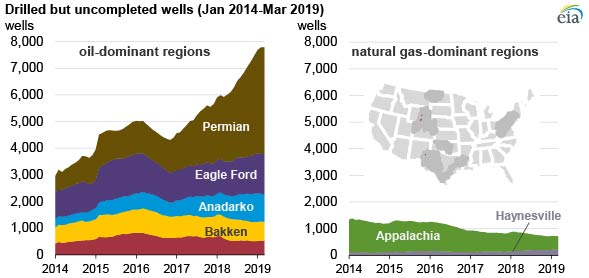
The number of drilled but uncompleted wells in seven key oil and natural gas production regions in the United States has increased over the last two years, reaching a high of 8,504 wells in February 2019, according to well counts in EIA’s Drilling Productivity Report (DPR). The most recent count, at 8,500 wells in March 2019, was 26% higher than the previous March.
Drilled but uncompleted wells, also known as DUCs, are oil and natural gas wells that have been drilled but have not yet undergone well completion activities to start producing hydrocarbons. The well completion process involves casing, cementing, perforating, hydraulic fracturing, and other procedures required to produce crude oil or natural gas.
The number of DUCs has generally increased since the end of 2016. A high inventory of DUCs may be attributable to economic factors or resource constraints. For example, a low oil and natural gas price environment may postpone well completion activities in areas where the wellhead break-even price is too high relative to the current market price. Another example may be the lack of available well completion crews to perform hydraulic fracture activities in areas of high demand. Takeaway capacity, or the ability to transport hydrocarbons through pipelines away from the resource, may also place additional constraints when pipeline networks are insufficient to accommodate supply.

In contrast to oil-directed regions, the number of DUCs in natural gas-dominated DPR regions such as the Appalachian and Haynesville regions has decreased by nearly half over the past three years, from 1,230 wells in March 2016 to 713 wells in March 2019. New pipelines in these regions have increased the ability to transport natural gas to demand centers in the Northeast and Midwest.
Production in the seven DPR regions, which are characterized by tight oil or shale gas formations, totaled 8.2 million barrels per day of crude oil and 77.1 billion cubic feet per day of natural gas in February 2019, or 70% of total U.S. crude oil production and 71% of total U.S. natural gas production.
EIA’s estimates of DUC counts may differ from other sources because of differences in methodology and assumptions. EIA develops its estimates of DUC counts using a consistent methodology and uniform assumptions across regions.
More information on drilling and production metrics is available in EIA’s Drilling Productivity Report, and more comprehensive information on total oil and natural gas production is available in EIA’s Monthly Crude Oil and Natural Gas Production Report.












